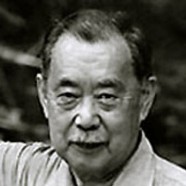 George Nakashima was born in 1905 in Spokane, WA, to Katsuharu and Suzu Nakashima. He studied architecture at the University of Washington, graduating with a Bachelor of Architecture. In 1931, after earning a master’s degree in architecture from M.I.T., George sold his car and purchased a round-the-world tramp steamship ticket. He spent a year in France living the life of a bohemian, and then went on to North Africa and eventually to Japan. While in Japan, George went to work for Antonin Raymond, an American architect who had collaborated with Frank Lloyd Wright on the Imperial Hotel. George toured Japan extensively, studying Japanese architecture and design.
George Nakashima was born in 1905 in Spokane, WA, to Katsuharu and Suzu Nakashima. He studied architecture at the University of Washington, graduating with a Bachelor of Architecture. In 1931, after earning a master’s degree in architecture from M.I.T., George sold his car and purchased a round-the-world tramp steamship ticket. He spent a year in France living the life of a bohemian, and then went on to North Africa and eventually to Japan. While in Japan, George went to work for Antonin Raymond, an American architect who had collaborated with Frank Lloyd Wright on the Imperial Hotel. George toured Japan extensively, studying Japanese architecture and design.
George returned to America and began to teach woodworking and to make furniture in Seattle, WA. Like others of Japanese ancestry, he was interred during the Second World War and sent to Camp Minidoka in Hunt, ID, in March 1942. At the camp he met Gentaro Hikogawa, who trained him in traditional Japanese carpentry. Under his tutelage, George learned to master traditional Japanese hand tools and joinery techniques. Perhaps more significant, he began to approach woodworking with discipline and patience, striving for perfection in every stage of construction.
In 1943, Antonin Raymond successfully sponsored Nakashima’s release from the camp and invited him to his farm in Solebury Township. In his studio and workshop, George explored the organic expressiveness of wood, choosing boards with knots and burls and figured grain. He designed furniture lines for Knoll, including the straight back chair, and Widdicomb-Mueller, and he also continued his private commissions. In 1973 Nelson Rockefeller commissioned 200 pieces for his house in Pocantico Hills, NY.
George is still honored for his unique craftsmanship and his oneness with nature. His exceptional wooden furniture is respected and coveted worldwide. His signature design was his large-scale tables made of large wood slabs with smooth tops but unfinished natural edges. Each table consists of multiple slabs connected with butterfly joints. George had a deep respect for trees and said that “A tree is perhaps our most intimate contact with nature.” In the 1980s he conceived the idea of building and gifting altars for peace for each continent of the world. These altars would be housed in centers for meditation, prayer, and activities for peace, making the world a better place. Today altars of his design are in the U.S, Russia, India and South Africa. His family continues his creativity and his philosophy of peace.
George created a body of work that would make his name synonymous with the best twentieth century American Art furniture. His home, studio, and workshop on Aquetong Road in Solebury Township was listed in the U. S. National Register of Historic Places in August 2008 and became a National Historic Landmark in April 2014. One of his workshops, located in Takamatsu City, Japan, currently houses a museum and gallery of his works.
George Nakashima passed away in 1990.
Click here to listen to an oral history interview of George Nakashima.


